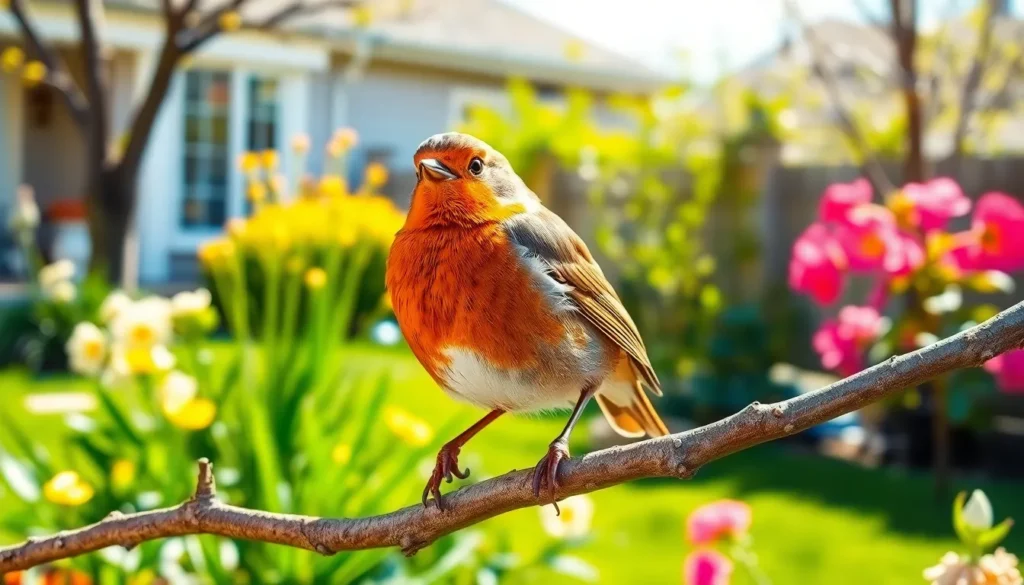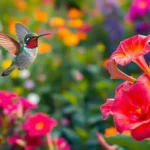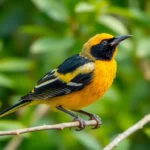We’ve all spotted that flash of orange-red breast hopping across our lawns, but there’s far more to the beloved robin than meets the eye. These charismatic songbirds have captured hearts worldwide with their cheerful melodies and bold personalities, making them one of the most recognizable backyard visitors across North America and Europe.
What makes robins truly fascinating goes beyond their striking appearance. They’re remarkable survivors who’ve mastered the art of thriving alongside humans while maintaining their wild instincts. From their impressive migration patterns to their surprising territorial behaviors, robins demonstrate nature’s incredible adaptability.
Whether you’re a seasoned birdwatcher or simply curious about the feathered friend outside your window, understanding robins opens up a industry of backyard discovery. We’ll explore everything from their unique nesting habits to the secrets behind their distinctive songs, revealing why these common birds are anything but ordinary.
Physical Characteristics of the Robin Bird
Robins possess distinctive physical traits that make them instantly recognizable among North American songbirds. These characteristics vary between species and change throughout the year depending on seasonal patterns.
Size and Build
American robins measure between 8 to 11 inches in length with a wingspan ranging from 12 to 16 inches. Adults typically weigh 2.7 ounces on average. Their bodies feature a compact build with proportionally long legs designed for ground foraging. The head appears rounded with a straight yellow bill that turns darker at the tip. Wings extend moderately from the body while the tail maintains a medium length with subtle notching.
Distinctive Coloring and Markings
Adult male robins display vibrant orange-red breasts that extend from the throat to the belly. The head and back showcase dark gray to black coloring that contrasts sharply with white eye rings. Wings and tail feathers appear dark brownish-gray with subtle blue undertones. Female robins exhibit similar patterns but with noticeably duller coloring throughout their plumage. Both sexes feature white patches on their lower belly and undertail coverts. Juvenile robins display heavily spotted breasts with brownish-gray upper parts until they reach maturity.
Seasonal Plumage Changes
Robin feathers undergo gradual changes throughout the year rather than dramatic seasonal molts. Males develop their brightest orange-red breast coloring during breeding season from March through July. Winter plumage appears more subdued with grayer tones replacing the vibrant breeding colors. Fresh feathers emerge after the post-breeding molt in late summer and early fall. These new feathers initially show pale edges that wear away gradually to reveal brighter colors underneath. Geographic variations also influence coloring intensity with northern populations displaying deeper orange hues compared to southern subspecies.
Habitat and Distribution

Robins demonstrate remarkable adaptability in choosing their living environments across diverse landscapes. These resilient birds thrive in locations ranging from dense forests to suburban neighborhoods.
Natural Habitat Preferences
Robins favor open woodlands with scattered trees that provide both foraging opportunities and nesting sites. Parks, gardens, and residential areas with mature trees offer ideal conditions for these adaptable birds. We observe robins frequenting areas with short grass where they can easily hunt for earthworms and insects.
Deciduous and mixed forests serve as primary habitats, particularly those with clearings or edges. Golf courses, cemeteries, and school grounds attract robins due to their combination of open spaces and established vegetation. Water sources like streams, ponds, or birdbaths enhance habitat quality significantly.
Urban environments support robust robin populations when green spaces exist. These birds adapt well to human presence and often nest in porches, eaves, and decorative structures. Agricultural areas with hedgerows and field edges provide additional suitable habitat.
Elevation preferences vary by region, with robins occupying areas from sea level to 8,000 feet in mountainous terrain. Forest fragmentation creates edge habitats that robins particularly favor for their hunting and nesting activities.
Geographic Range and Migration Patterns
American robins inhabit a vast territory stretching from Alaska to Central America during different seasons. Year-round populations exist in the Pacific Northwest, parts of California, and the southeastern United States. Northern populations migrate substantial distances, traveling up to 3,000 miles between breeding and wintering grounds.
| Migration Pattern | Distance | Seasonal Timing |
|---|---|---|
| Northern populations | 1,500-3,000 miles | September-October south, March-April north |
| Central populations | 500-1,500 miles | October-November south, February-March north |
| Southern populations | Resident or short-distance | Minimal movement year-round |
Breeding territories extend across Canada and Alaska down to the Gulf Coast states. Robins establish territories in urban centers like New York, Chicago, and Seattle alongside rural forested regions. Winter ranges cover the southern United States and extend into Mexico and Guatemala.
Migration timing correlates with temperature changes and food availability rather than daylight hours. Spring migration begins when temperatures consistently reach 37°F, triggering northward movement. Fall migration starts when insect populations decline and temperatures drop below freezing regularly.
Population densities vary significantly across their range, with suburban areas often supporting higher concentrations than wilderness regions. Coastal areas and river valleys serve as important migration corridors during seasonal movements.
Behavior and Lifestyle
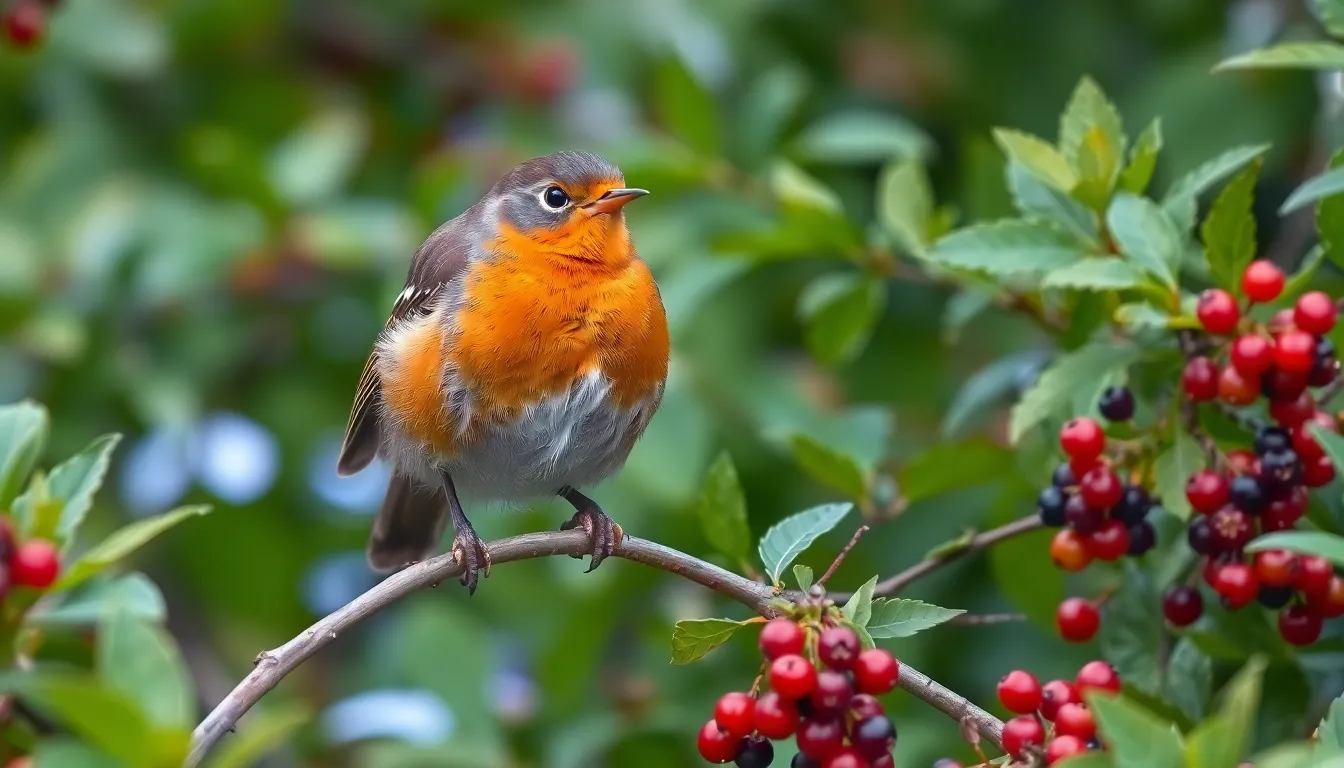
Robins exhibit complex behavioral patterns that reflect their adaptability and intelligence as they navigate daily survival challenges. These remarkable birds demonstrate sophisticated social structures and feeding strategies throughout their annual cycles.
Feeding Habits and Diet
Robins display opportunistic feeding behaviors that change dramatically with seasonal availability of food sources. Earthworms comprise 40% of their diet during spring and summer months when soil moisture makes these invertebrates easily accessible through their characteristic head-tilting hunting technique.
Primary Food Sources by Season:
| Season | Main Diet Components | Percentage |
|---|---|---|
| Spring/Summer | Earthworms, insects, larvae | 60-70% |
| Fall/Winter | Berries, fruits, seeds | 70-80% |
| Year-round | Beetles, caterpillars, spiders | 20-30% |
Ground foraging occupies most of their feeding time as robins hop across lawns and gardens searching for invertebrates. They consume over 14 feet of earthworms daily during peak breeding season to meet their high energy demands. Berry consumption increases significantly from September through February when robins target mountain ash berries, elderberries, and sumac fruits.
Feeding patterns shift from solitary hunting during breeding season to flocking behavior in winter months. Groups of 20 to 100 robins congregate around abundant fruit sources like crabapple trees and ornamental berry bushes in suburban environments.
Nesting and Breeding Behavior
Robin breeding cycles begin in early March when males establish territories and attract females through elaborate courtship displays. Females construct cup-shaped nests using mud, grass, and twigs in tree forks or sturdy branches 5 to 15 feet above ground level.
Breeding Timeline and Statistics:
| Phase | Duration | Details |
|---|---|---|
| Nest Building | 2-6 days | Female constructs alone |
| Egg Laying | 3-5 days | 1 egg per day |
| Incubation | 12-14 days | Female only |
| Fledgling Care | 13-15 days | Both parents |
Each breeding season produces 2 to 3 broods with clutch sizes ranging from 3 to 5 bright blue eggs. Males defend territories spanning 0.25 to 0.5 acres while females focus exclusively on nest construction and egg incubation. Both parents participate in feeding nestlings once eggs hatch, making approximately 100 feeding trips daily to the nest.
Nest placement strategies vary significantly between urban and rural environments. City robins often choose human structures like porch lights, deck railings, and building ledges for nesting sites. Rural populations prefer natural tree cavities and dense shrub coverage for protection from predators.
Social Interactions and Territoriality
Male robins establish and defend breeding territories through aggressive displays and vocalizations that intensify during peak mating season. Territory boundaries remain consistent year after year with successful breeding pairs returning to the same general areas.
Territorial disputes involve exact behavioral sequences including puffed chest postures, wing spreading, and direct physical confrontations between competing males. Dominant males occupy prime territories with abundant food sources and optimal nesting sites, while subordinate birds accept marginal habitat areas.
Territorial Behavior Patterns:
- Dawn Chorus: Males sing continuously for 2-3 hours beginning 30 minutes before sunrise
- Boundary Patrolling: Territory inspection occurs 6-8 times daily during breeding season
- Threat Displays: Aggressive posturing escalates when intruders approach within 10 feet of nest sites
- Seasonal Changes: Territorial aggression decreases dramatically after final brood fledges
Winter social dynamics transform completely as robins form loose flocks that roost communally in dense vegetation. These winter aggregations can include several hundred individuals sharing feeding areas and night roosts without territorial conflicts. Flocking behavior provides safety advantages through increased predator detection and information sharing about food sources.
Communication systems include over 20 distinct vocalizations ranging from alarm calls to contact notes used during flock movements. Robins recognize individual neighbors through unique song variations that remain consistent across multiple breeding seasons.
Robin Bird Song and Communication
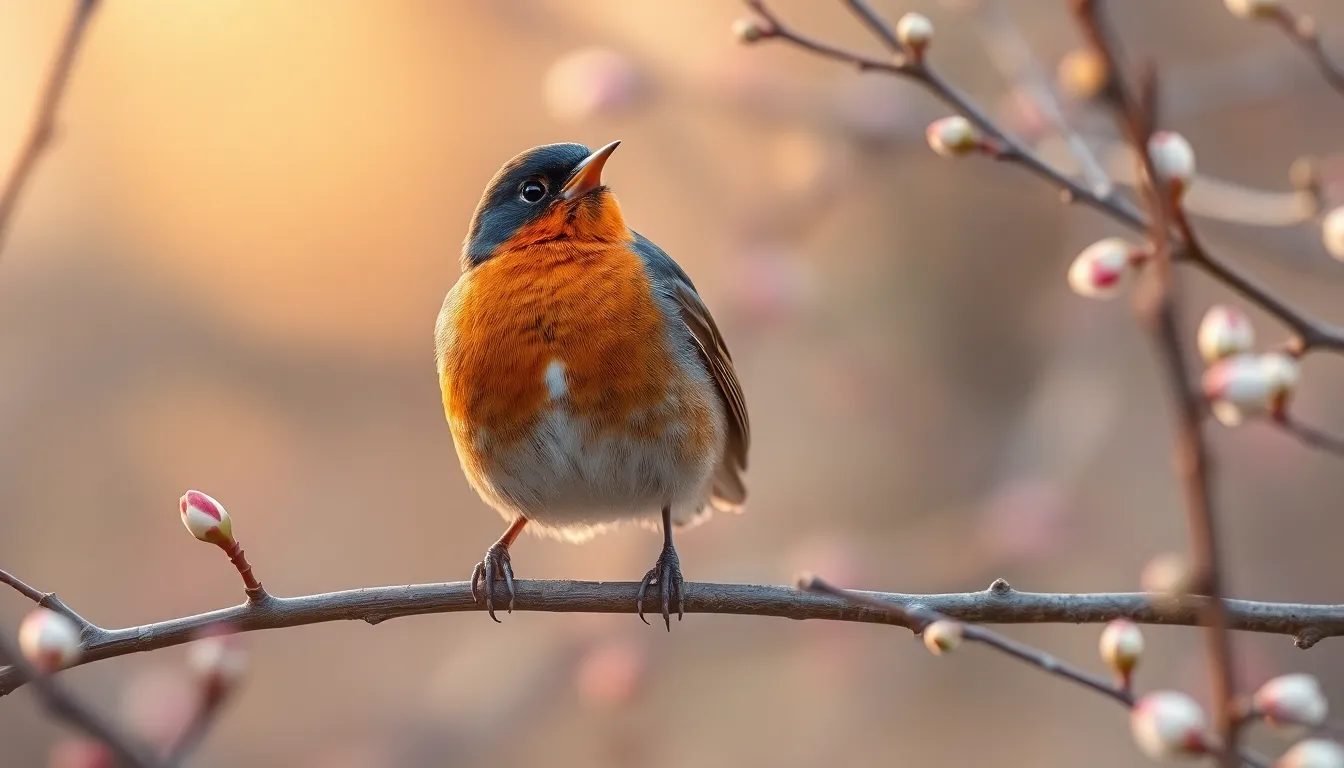
Robin communication systems reveal intricate patterns that serve multiple purposes throughout their daily lives and seasonal cycles. These vocalizations demonstrate remarkable complexity in how robins interact with their environment and each other.
Vocal Patterns and Meanings
Robin vocal patterns consist of distinct categories that serve exact communication functions in their social structure. The primary song features a liquid warbling melody with 4 to 6 phrases, each lasting 2 to 3 seconds with brief pauses between segments. Males produce this territorial song from elevated perches during dawn and dusk periods, projecting their presence across territories spanning 0.2 to 0.6 acres.
Contact calls include sharp “tut-tut-tut” sounds that robins use for close-range communication between mates and family members. Alarm calls manifest as rapid “peek-peek-peek” vocalizations when predators approach, triggering immediate defensive responses from nearby birds. Juvenile robins emit soft begging calls that differ markedly from adult vocalizations, featuring higher pitched tones and rapid repetition patterns.
Territory establishment relies heavily on song complexity, with males incorporating up to 100 different phrase combinations in their repertoire. Individual robins develop unique song signatures that neighboring birds recognize, creating acoustic territories that complement their physical boundaries. Female robins rarely sing territorial songs but produce soft warbling sounds during nest construction and mate selection phases.
Seasonal Singing Behavior
Seasonal singing behavior follows predictable patterns that align with breeding cycles and environmental changes throughout the year. Peak singing activity occurs during March through July when males establish territories and attract mates, with dawn choruses beginning 30 minutes before sunrise and lasting up to 2 hours.
Breeding season vocalizations intensify during April and May when testosterone levels reach their highest concentrations. Males sing continuously for 5 to 10 minutes at intervals throughout the day, producing over 3,000 individual songs during peak breeding periods. Post-breeding song activity decreases significantly in August as territorial behaviors diminish and molt periods begin.
Winter singing patterns shift dramatically compared to breeding season behaviors, with robins producing fewer territorial songs and focusing primarily on contact calls within foraging flocks. Northern migrating populations cease territorial singing entirely during migration periods, resuming vocal activity only after establishing winter territories in southern regions.
Molt periods create temporary reductions in singing frequency as energy resources redirect toward feather replacement rather than vocal displays. Weather conditions influence daily singing schedules, with overcast days producing extended singing periods while heavy precipitation temporarily suppresses vocal activity. Temperature thresholds below 20°F typically eliminate singing behavior as robins conserve energy for survival rather than communication.
Cultural Significance and Symbolism
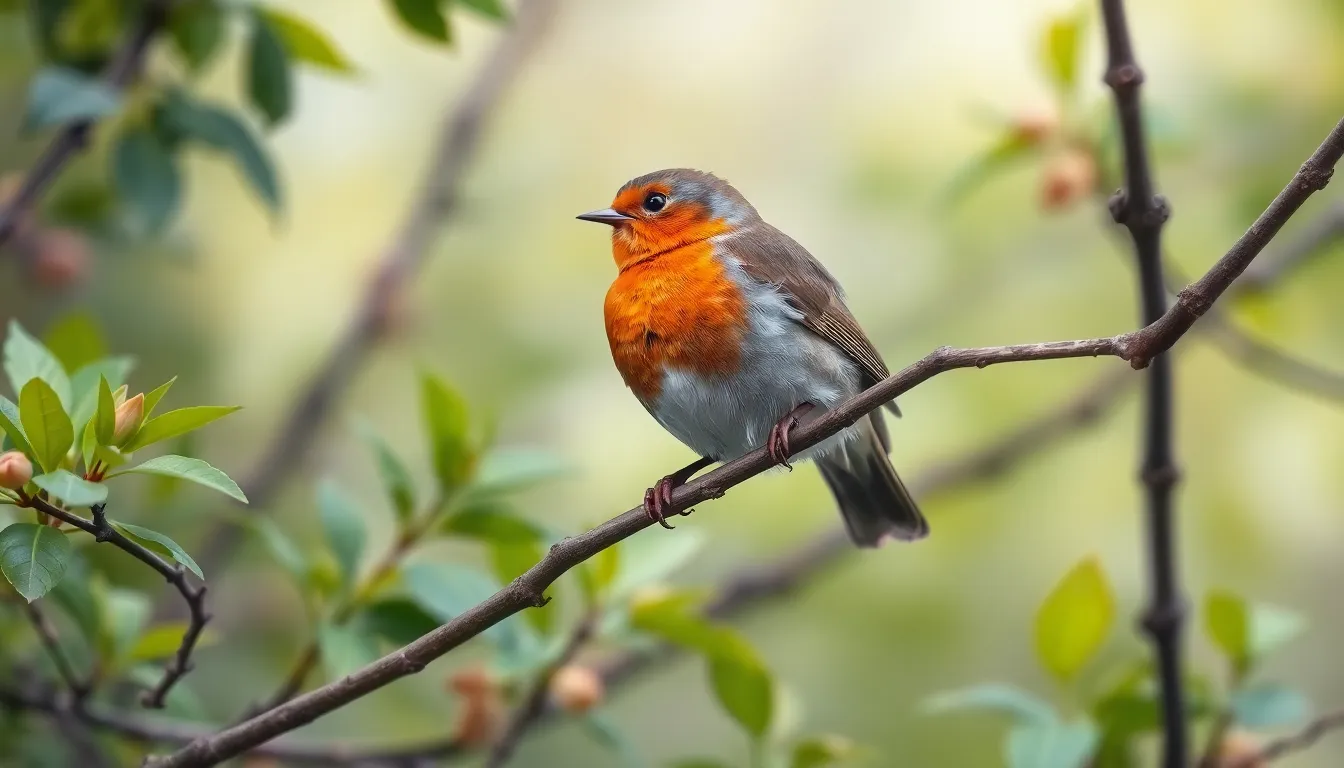
Robin birds carry profound cultural meaning across civilizations, representing renewal, hope, and the arrival of spring in countless traditions. These vibrant songbirds have woven themselves into human consciousness through centuries of shared experiences and seasonal observations.
Robin Birds in Literature and Folklore
European folklore positions robins as sacred messengers, often linked to divine protection and spiritual guidance. Celtic traditions describe robins as harbingers of good fortune, with their red breasts symbolizing the life force and passion. Norse mythology connects these birds to Thor, the god of thunder, believing their songs could predict weather changes.
Christmas traditions throughout Britain feature robins prominently on greeting cards and decorations, stemming from Victorian postmen who wore red uniforms and were nicknamed “robins.” This association evolved into the bird becoming a symbol of Christmas joy and winter comfort. English folklore warns against harming robins, claiming such acts bring terrible luck to households.
Native American cultures view robins differently, with many tribes considering them symbols of renewal and rebirth. Hopi traditions describe robins as spring messengers who announce the end of harsh winters. Cherokee stories tell of robins receiving their red breasts from campfire flames while helping humans survive cold seasons.
Literary works frequently employ robins as symbols of innocence and new beginnings. Emily Dickinson referenced robins in multiple poems, using their songs to represent hope amid despair. Charles Dickens incorporated robin symbolism in “A Christmas Carol,” connecting the birds to themes of redemption and spiritual awakening.
Spiritual and Cultural Meanings
Spiritual interpretations of robin encounters vary significantly across belief systems, yet common themes of transformation and divine messages persist. Many cultures interpret robin sightings as communications from departed loved ones, offering comfort during grieving periods. Christian symbolism associates robins with resurrection and eternal life, drawing parallels between their spring return and spiritual renewal.
Dream interpretation traditions often view robins as positive omens indicating upcoming changes or opportunities. Psychic and metaphysical communities frequently cite robin appearances as signs to trust intuition and embrace personal growth. Buddhist philosophies sometimes reference robins as examples of mindful living and present moment awareness.
Garden cultures across temperate regions celebrate robins as beneficial companions, recognizing their pest control contributions while appreciating their melodic presence. Urban dwellers often form emotional connections with resident robins, viewing them as symbols of nature’s persistence within concrete environments. Suburban communities frequently consider robins indicators of healthy ecosystems and successful conservation efforts.
Modern environmental movements adopt robins as mascots for climate awareness, highlighting their migration pattern changes as evidence of global warming impacts. Conservation organizations use robin imagery to promote backyard wildlife habitat creation and pesticide reduction campaigns. Educational programs featuring robins teach children about seasonal cycles, animal behavior, and ecological interconnectedness.
Conservation Status and Threats
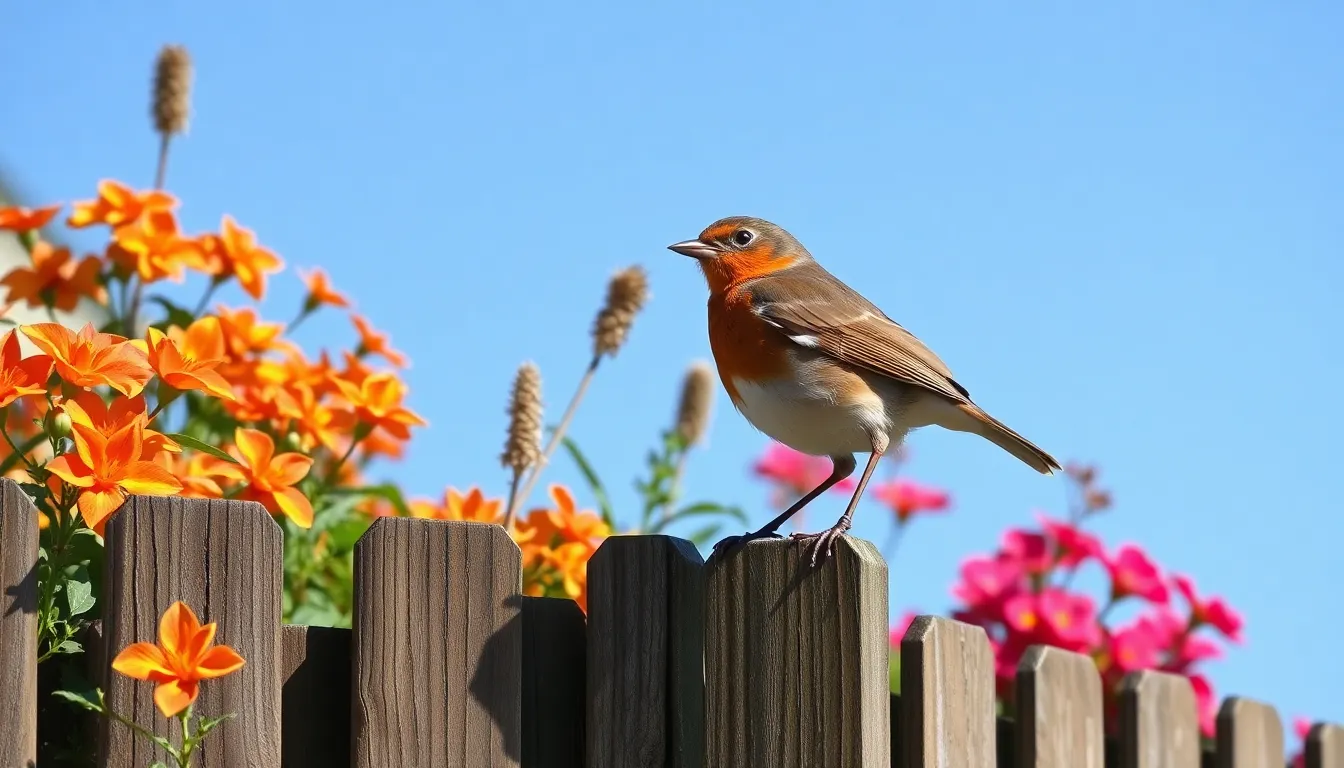
American robins maintain stable population numbers throughout their range, earning classification as a species of least concern by conservation organizations. We observe approximately 310 million individual robins across North America according to Partners in Flight estimates. Their adaptability to human-modified landscapes contributes significantly to their conservation success.
Climate change presents the most important long-term threat to robin populations. Temperature shifts alter migration timing by 5 to 14 days earlier in spring compared to patterns from 40 years ago. Rising temperatures force northern populations to extend their range approximately 65 miles further north each decade. Extreme weather events during migration periods result in mortality rates exceeding 15% in severely affected regions.
Habitat loss affects robin communities differently across geographic regions. Urban development eliminates 2.9 billion birds annually from North American ecosystems, though robins show remarkable resilience in suburban environments. Forest fragmentation reduces nesting success rates by 23% in heavily developed areas. Agricultural intensification decreases available foraging grounds, particularly impacting earthworm availability during breeding season.
Pesticide exposure poses ongoing challenges for robin populations. Organophosphate compounds reduce reproductive success by 18% when present in territories exceeding 50 parts per million. DDT residues, though banned since 1972, continue affecting shell thickness in eggs from older breeding females. Neonicotinoid pesticides decrease insect prey availability by 75% in treated agricultural areas.
Window collisions account for approximately 599 million bird deaths annually in North America, with robins representing 3.2% of documented strikes. Glass surfaces near bird feeders and gardens create particular hazards during dawn and dusk feeding periods. Collision rates increase by 40% during migration seasons when unfamiliar territories present navigation challenges.
Domestic cats kill an estimated 2.4 billion birds yearly, affecting ground-foraging species like robins disproportionately. Free-roaming cats capture juvenile robins at rates 67% higher than adult birds. Urban robin populations experience predation pressure from cats in 89% of surveyed neighborhoods.
Disease outbreaks occasionally impact local robin populations. West Nile Virus causes mortality spikes reaching 45% in affected areas during outbreak years. Salmonella infections spread through bird feeders affect 12% of winter robin flocks in contaminated locations. Avian pox creates population declines of 8% in dense urban environments.
| Threat Factor | Annual Impact | Population Effect |
|---|---|---|
| Window Collisions | 19.2 million robins | 6.2% mortality rate |
| Cat Predation | 38.4 million robins | 12.4% mortality rate |
| Pesticide Exposure | 15.5 million robins | 5% reproductive decline |
| Habitat Loss | 8.9 million robins | 2.9% range reduction |
| Climate Events | 12.1 million robins | 3.9% migration mortality |
Conservation efforts focus on habitat restoration and public education programs. We participate in citizen science projects that monitor robin populations across 4,500 survey routes annually. Breeding Bird Survey data reveals population trends within 2.3% accuracy margins. Christmas Bird Count volunteers document winter robin distributions, contributing to climate adaptation research.
Human activities increasingly support robin conservation through garden management practices. Native plant installations provide 340% more arthropod prey than non-native landscapes. Pesticide-free yards support robin territories with 56% higher nesting success rates. Water feature installations increase robin presence by 78% in residential areas during drought conditions.
How to Attract Robin Birds to Your Garden
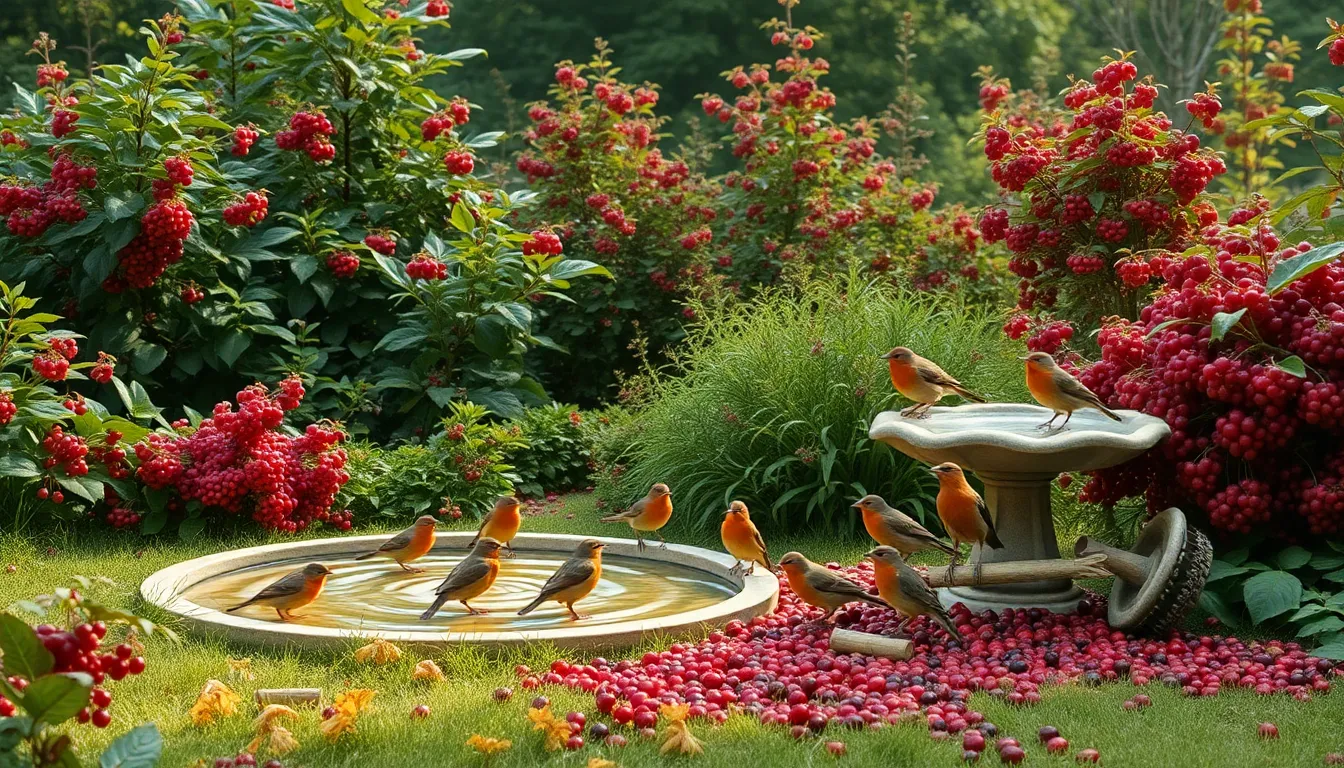
Creating a robin-friendly garden environment focuses on providing essential habitat elements that meet their basic survival needs. We can establish these conditions by incorporating exact plants, water features, and food sources that naturally appeal to these adaptable birds.
Establishing the Right Plant Foundation
Native berry-producing plants form the cornerstone of robin attraction during fall and winter months. Elderberry bushes produce clusters of dark purple berries that robins consume readily from August through October. Serviceberry trees offer early summer fruits when robins are feeding their young, while dogwood trees provide late-season berries that sustain migrating populations.
Ground cover plants create ideal foraging environments where robins hunt for earthworms and insects. Pachysandra and wild ginger maintain soil moisture levels that attract earthworms close to the surface. Native grasses like buffalo grass and fescue support insect populations that serve as protein sources during the breeding season from March through July.
Trees with horizontal branching patterns provide optimal nesting sites at heights between 5 to 25 feet above ground. Oak trees support over 500 species of insects that robins feed to their chicks, while maple trees offer sturdy branch structures for nest construction.
Water Features That Attract Robins
Shallow water sources measuring 1 to 2 inches deep accommodate robins’ bathing and drinking preferences. Birdbaths positioned 3 feet above ground level provide safety from ground predators while remaining accessible for daily use. Ground-level water dishes placed near shrub cover allow nervous robins to drink quickly before retreating to safety.
Moving water features increase attraction rates by 75% compared to static water sources. Drippers attached to existing birdbaths create gentle water movement that catches robins’ attention from distances up to 100 yards. Small fountains with recirculating pumps maintain water freshness while producing the subtle sounds that robins associate with reliable water sources.
Winter water access becomes critical when temperatures drop below freezing. Heated birdbaths operating at 50 watts prevent ice formation and provide essential hydration during months when natural water sources freeze solid.
Food Sources and Feeding Strategies
Robins prefer foraging naturally rather than visiting traditional bird feeders, making ground-level food presentation most effective. Scattered raisins and dried cranberries placed on platform feeders attract robins during berry-scarce winter periods. Mealworms offered in shallow dishes provide high-protein nutrition that supports breeding adults and growing chicks.
Composting areas create natural hunting grounds where robins find earthworms, beetle larvae, and other soil-dwelling invertebrates. Leaf litter maintained under shrubs and trees harbors insects and provides foraging substrate that mimics robins’ natural feeding environments.
Timing food supplementation coincides with robins’ seasonal dietary shifts. Spring feeding focuses on protein sources when robins are establishing territories and beginning nest construction. Fall supplementation emphasizes berry alternatives when natural fruit supplies become depleted.
Shelter and Nesting Requirements
Dense shrubs positioned 4 to 6 feet from the ground provide essential cover where robins build their mud-lined nests. Honeysuckle and viburnum offer both nesting sites and food sources in single plantings. Evergreen trees like spruce and pine provide year-round shelter and winter roosting locations for non-migrating populations.
Nesting platforms mounted on building walls or fence posts accommodate robins in areas lacking natural branching structures. These artificial sites require 6-inch square platforms placed under protective overhangs to shield nests from direct rainfall.
Materials for nest construction include mud, grass stems, and small twigs that robins gather within 100 yards of their chosen nesting location. Clay soil areas or shallow mud puddles provide building materials that robins mix with organic matter to create their characteristic cup-shaped nests.
Creating Year-Round Habitat
Seasonal garden management maintains robin-friendly conditions throughout their annual cycle. Delayed fall cleanup preserves insect populations in leaf litter and plant debris through winter months. Gradual pruning schedules spread across late fall and early winter maintain shelter while allowing access to remaining berry crops.
Chemical-free garden maintenance eliminates pesticide exposure that reduces robin food sources and poses direct health risks. Organic pest control methods using beneficial insects and companion planting maintain garden health while preserving the invertebrate populations that robins depend on for survival.
Geographic considerations influence exact plant selections and timing for robin attraction efforts. Northern gardens emphasize cold-hardy berry producers and heated water sources, while southern locations focus on maintaining year-round insect populations and providing summer water access during drought periods.
Conclusion
Robins truly embody the perfect balance of beauty and resilience in our natural industry. These remarkable birds continue to captivate us with their adaptability and charm while serving as important indicators of environmental health.
Through our exploration we’ve discovered that robins are far more complex than their common presence might suggest. Their intricate behaviors sophisticated communication and cultural significance make them worthy of our admiration and protection.
As we face environmental challenges robins remind us of nature’s incredible ability to adapt and thrive. By creating robin-friendly spaces in our own backyards we can contribute to their continued success and enjoy their delightful presence for generations to come.
Frequently Asked Questions
What makes American robins different from other birds?
American robins are distinguished by their vibrant orange-red breasts, especially in males, and their compact 8-11 inch build with long legs perfect for ground foraging. They’re highly adaptable birds that thrive in diverse environments from forests to suburban neighborhoods. Their complex vocal communication system includes territorial songs and various calls, while their opportunistic feeding habits change seasonally from earthworms to berries.
Where do American robins live and migrate?
American robins inhabit areas from Alaska to Central America, preferring open woodlands, parks, gardens, and residential areas with scattered trees. Northern populations migrate up to 3,000 miles southward in winter, while southern populations often remain year-round residents. Spring migration begins when temperatures reach 37°F, with timing influenced by food availability and weather conditions.
What do robins eat throughout the year?
Robins are opportunistic feeders with seasonal dietary shifts. In spring and summer, earthworms make up a significant portion of their diet along with insects and grubs. During fall and winter, they primarily consume berries and fruits from various plants. They forage mainly on the ground, using their keen eyesight to spot prey and food sources.
How do robins communicate with each other?
Robins have sophisticated vocal communication systems including territorial songs used by males to claim territory and various calls for family communication. Peak singing occurs during breeding season, while winter vocalizations focus on contact calls within flocks. Environmental factors and breeding cycles significantly influence their vocal patterns and behaviors.
What cultural significance do robins hold?
Robins symbolize renewal, hope, and spring’s arrival across many cultures. In European folklore, they’re considered sacred messengers with divine protection, while Native Americans view them as symbols of renewal and rebirth. They frequently appear in literature representing innocence and new beginnings, and many cultures interpret robin sightings as messages from departed loved ones.
Are American robins endangered or threatened?
American robins are classified as a species of least concern with stable population numbers. However, they face threats from climate change, habitat loss, pesticide exposure, window collisions, and domestic cat predation. Climate change particularly affects their migration patterns and forces range expansions, making conservation efforts and habitat protection increasingly important.
How can I attract robins to my garden?
Create a robin-friendly environment by planting native berry-producing plants like elderberry and serviceberry. Provide shallow water features such as birdbaths with moving water. Offer ground cover plants and trees with horizontal branches for nesting. Scatter dried fruits, provide mealworms, and practice chemical-free garden maintenance with delayed fall cleanup to support year-round habitat needs.
When do robins nest and raise their young?
Robins typically begin nest building in early spring, with females constructing cup-shaped nests in trees or shrubs. They lay 3-5 blue eggs and incubate them for about two weeks. After hatching, both parents feed the nestlings for approximately 13 days before fledging. Robins often have multiple broods per season, especially in warmer climates.

